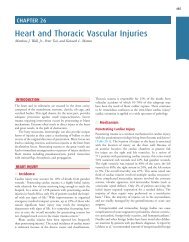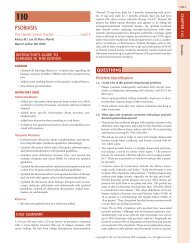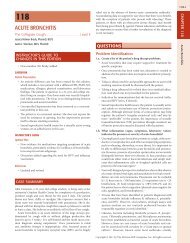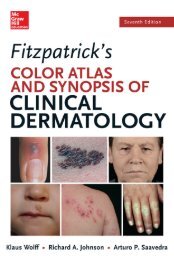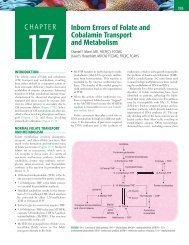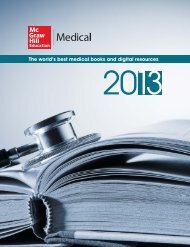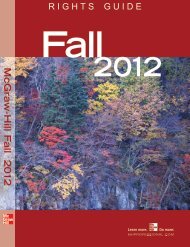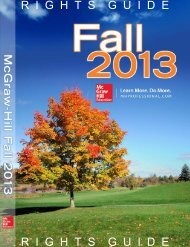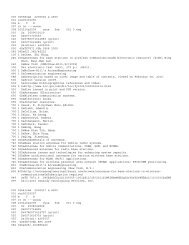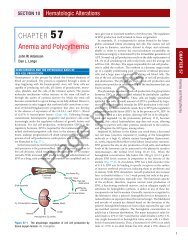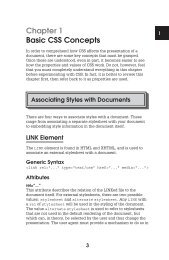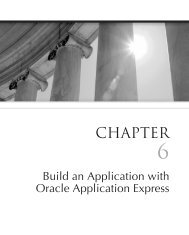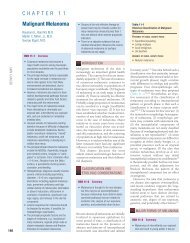Oropharyngeal & Esophageal Motility Disorders - McGraw-Hill ...
Oropharyngeal & Esophageal Motility Disorders - McGraw-Hill ...
Oropharyngeal & Esophageal Motility Disorders - McGraw-Hill ...
Create successful ePaper yourself
Turn your PDF publications into a flip-book with our unique Google optimized e-Paper software.
164<br />
164<br />
00 13<br />
` General Considerations<br />
<strong>Oropharyngeal</strong> and esophageal motility disorders have significant<br />
impact on patients’ quality of life. Mechanical and<br />
functional problems may interact to cause symptoms; thus,<br />
diagnosis of these disorders can be challenging.<br />
Dysphagia (difficulty swallowing) must be distinguished<br />
from other symptoms such as odynophagia (pain on swallowing,<br />
suggestive of a defect in mucosal integrity, eg,<br />
from irradiation, inflammation, or infection) and aphagia<br />
(inability to swallow, generally suggestive of mechanical<br />
obstruction in patients presenting acutely). Symptoms that<br />
do not necessarily correlate with the immediate process of<br />
swallowing, such as rumination and globus sensation, should<br />
also be discerned.<br />
Dysphagia can be differentiated into two categories:<br />
(1) oropharyngeal (also called transfer dysphagia), arising<br />
from disorders affecting the oropharynx, larynx, and upper<br />
esophageal sphincter (UES); and (2) esophageal, arising from<br />
the esophagus, lower esophageal sphincter (LES), or gastroesophageal<br />
junction. The causes of dysphagia are many, and<br />
specific entities are considered here.<br />
Massey BT, Shaker R. Oral pharyngeal and upper esophageal<br />
sphincter motility disorders. GI <strong>Motility</strong> Online. Available at:<br />
http://www.nature.com/gimo/index.html; doi: 10.1038/gimo19,<br />
2006.<br />
Paterson WG, Goyal RK, Habib FI. <strong>Esophageal</strong> motility disorders.<br />
GI <strong>Motility</strong> Online. Available at: http://www.nature.com/gimo/<br />
index.html; doi: 10.1038/gimo20, 2006.<br />
Wise JL, Murray IA. Oral, pharyngeal and esophageal motility<br />
disorders in systemic diseases. GI <strong>Motility</strong> Online. Available at:<br />
http://www.nature.com/gimo/index.html; doi: 10.1038/gimo40,<br />
2006.<br />
<strong>Oropharyngeal</strong> &<br />
<strong>Esophageal</strong> <strong>Motility</strong><br />
<strong>Disorders</strong><br />
Arun Chaudhury, MD<br />
Hiroshi Mashimo, MD, PhD<br />
OROPHARYNGEAL MOTILITY DISORDERS<br />
OROPHARYNGEAL DYSPHAGIA<br />
`<br />
`<br />
`<br />
ESSENTIALS OF DIAGNOSIS<br />
History of poor oral bolus preparation and control, difficulty<br />
in initiating a swallow, nasal and oral regurgitation,<br />
aspiration and coughing with swallowing, food sticking<br />
at the level of the throat.<br />
Evidence of a generalized neuromuscular disorder.<br />
Documentation by videofluoroscopic swallowing study<br />
(VFSS).<br />
` General Considerations<br />
Many neuromuscular disorders can cause dysphagia<br />
(Table 13–1). Among these are various disorders causing<br />
cortical lesions; supranuclear, nuclear, and cranial nerve<br />
lesions; defects of neurotransmission at the motor end<br />
plates; and muscular diseases.<br />
Many patients with dysphagia are elderly and hence<br />
develop this symptom secondary to other disorders (eg, stroke).<br />
History of strokes or other neurologic illnesses, nasal regurgitation<br />
and frequent coughing immediately upon swallowing,<br />
and poor oral coordination of bolus formation or dysphonia<br />
may help suggest the greater likelihood of oropharyngeal<br />
dysphagia over esophageal dysmotility, but diagnosis, assessment<br />
of severity, and therapeutic intervention are generally<br />
guided by VFSS.
OROPHARYNGEAL & ESOPHAGEAL MOTILITY DISORDERS<br />
Table 13–1. Neuromuscular disorders causing<br />
oropharyngeal dysphagia.<br />
1. Diseases of cerebral cortex and brainstem<br />
a. With altered consciousness or dementia<br />
• Dementias, including Alzheimer disease<br />
• Altered consciousness, metabolic encephalopathy, encephalitis,<br />
meningitis, cerebrovascular accident, brain injury<br />
b. With normal cognitive functions<br />
• Brain injury<br />
• Cerebral palsy<br />
• Rabies, tetanus, neurosyphilis<br />
• Cerebrovascular disease<br />
• Parkinson disease and other extrapyramidal lesions<br />
• Multiple sclerosis (bulbar and pseudobulbar palsy)<br />
• Amyotrophic lateral sclerosis (motor neuron disease)<br />
• Poliomyelitis and post-poliomyelitis syndrome<br />
2. Diseases of cranial nerves (V, VII, IX, X, XII)<br />
a. Basilar meningitis (chronic inflammatory, neoplastic)<br />
b. Nerve injury<br />
c. Neuropathy (Guillain-Barré syndrome, Bell palsy, afamilial<br />
dysautonomia, sarcoid, diabetic, and other causes)<br />
3. Neuromuscular<br />
a. Myasthenia gravis<br />
b. Eaton-Lambert syndrome<br />
c. Botulinum toxin<br />
d. Aminoglycosides and other drugs<br />
4. Muscle disorders<br />
a. Myositis (polymyositis, dermatomyositis, sarcoidosis)<br />
b. Metabolic myopathy (mitochondrial myopathy, thyroid myopathy)<br />
c. Primary myopathies (myotonic dystrophy, oculopharyngeal myopathy)<br />
d. Acute and chronic radiation injury<br />
Adapted, with permission, from Goyal RK. Dysphagia. In: Fauci AS,<br />
Braunwald E, Kasper DL, et al (editors). Harrison’s Principles of<br />
Internal Medicine, 17th ed. <strong>McGraw</strong>-<strong>Hill</strong>, 2008:237–240.<br />
` Clinical Findings<br />
A. Symptoms and Signs<br />
History and physical examination provide the most valuable<br />
information in making the diagnosis. Defects in different<br />
phases of oropharyngeal swallowing should be identified by<br />
careful analysis of symptoms and signs.<br />
Defects in the oral preparatory phase of swallowing<br />
manifest as chewing problems, oral stasis of food, inability<br />
to form a bolus, and coughing, choking, or aspiration pneumonia<br />
from regurgitation and aspiration. These symptoms<br />
occur during or immediately after the onset of swallowing.<br />
In disorders of neuromuscular dysfunction, liquids are usually<br />
more problematic than solids in causing symptoms of<br />
misdirection. On the other hand, secondary causes from<br />
oral mucosal lesions (eg, aphthous ulcers, herpetic lesions,<br />
mucositis), dental problems, or decreased saliva and xerostomia<br />
(eg, medications, Sjögren) may lead to poor processing<br />
165<br />
of the bolus and are often less problematic with moistened<br />
foods or liquids.<br />
Generally, problems in the pharyngeal phase result in<br />
dysphagia, which the patient localizes to the throat. Often<br />
the patient makes repeated attempts to clear the throat of<br />
food or saliva.<br />
Abnormalities of the UES phase have no distinctive<br />
symptoms, but impaired UES opening further impairs<br />
pharyngeal transport and may aggravate the symptoms of<br />
pharyngeal stasis. On the other hand, a hypotonic UES may<br />
lead to esophagopharyngeal reflux and aspiration not related<br />
to swallowing.<br />
Because many neuromuscular structures involved in<br />
swallowing are also involved in speech, dysarthria and dysphonia<br />
are common in these patients. Moreover, patients<br />
usually have evidence of neuromuscular defects in other<br />
parts of the body. Many patients with oropharyngeal dysphagia<br />
have impaired consciousness and cognitive functions<br />
that may make evaluation difficult.<br />
B. Videofluoroscopic Swallowing Study (VFSS)<br />
VFSS is the study of choice for the evaluation of oropharyngeal<br />
dysphagia (Figure 13–1). VFSS allows slowmotion<br />
replay of oropharyngeal swallowing. This aids in identifying<br />
defects of the oropharyngeal phase of swallowing, which<br />
normally takes less than a second to complete. Different<br />
consistencies of food and various swallowing maneuvers can<br />
be used during the study to assess for retention or aspiration.<br />
Barium swallow or an upper gastrointestinal series is not<br />
useful in evaluation of oropharyngeal dysphagia. Plain radiographs<br />
and computed tomography (CT) scan of the neck are<br />
useful in evaluating structural lesions such as tumors and<br />
cysts. Imaging studies should be obtained prior to upper<br />
endoscopy, because pharyngeal and upper esophageal abnormalities<br />
such as diverticula and malignant strictures can<br />
perforate in this poorly visualized region.<br />
Gramigna GD. How to perform videofluoroscopic swallowing<br />
studies. GI <strong>Motility</strong> Online. Available at: http://www.nature.<br />
com/gimo/index.html; doi: 10.1038/gimo95, 2006.<br />
C. Manometry<br />
Because of the complex anatomy of the oral and pharyngeal<br />
passages and the speed of coordinated contractions, intraluminal<br />
manometry is not usually helpful. However, it may be<br />
useful in the evaluation of upper esophageal function and<br />
resistance to flow across the UES.<br />
D. Videoendoscopy<br />
Regular upper endoscopy is not helpful in the evaluation of<br />
oropharyngeal dysphagia; however, videoendoscopy, available<br />
at some specialized centers, can provide information<br />
about oropharyngeal dysfunction.
` Differential Diagnosis<br />
166<br />
CHAPTER 13<br />
A B C D<br />
Figure 13–1. Radiologic appearance of oropharyngeal motility disorders. A: Frontal view of the pharynx demonstrates<br />
aspiration of retained bolus. Note that there is retention of contrast in the valleculae (v) and piriform sinuses (ps).<br />
No swallow is taking place, yet there is entry of contrast into the laryngeal vestibule (vé) and between the vocal folds<br />
and in the ventricle (arrows). B: A stop-frame print from a cinepharyngogram in the lateral position shows incomplete<br />
laryngeal closure during swallowing with laryngeal penetration (arrows) and aspiration (arrowheads) down into the<br />
trachea. The bolus is passing through the open cricopharyngeus into the cervical esophagus. Degenerative change<br />
is noted in the cervical spine. C: Cricopharyngeal bar. D: Zenker diverticulum. (Reproduced, with permission, from<br />
(A) Jones B (editor): Normal and Abnormal Swallowing: Imaging in Diagnosis and Therapy, 2nd edition. Springer-Verlag,<br />
2003; (B) Jones B, Donner MW (editors): Normal and Abnormal Swallowing: Imaging in Diagnosis and Therapy. Springer-<br />
Verlag, 1991.)<br />
Figure 13–2 is an algorithm outlining an approach to the<br />
patient with oropharyngeal dysphagia.<br />
` Complications<br />
The major complications of oropharyngeal dysphagia are<br />
fatal pulmonary aspiration and pneumonia, malnutrition,<br />
and weight loss.<br />
` Treatment<br />
Evaluation and management by a deglutition team consisting<br />
of a deglutitionist (speech and swallow therapist), radiologist,<br />
gastroenterologist, otolaryngologist, and neurologist provide<br />
the best outcome in the care of these patients. Deglutitionists<br />
assess the risk of aspiration, type of food, and patient posture<br />
that is most likely to prevent aspiration and facilitate safe<br />
swallowing. Certain rehabilitative exercises to strengthen<br />
swallowing muscles may be helpful. Electrical stimulation of<br />
muscles is also being explored as a newer avenue of therapy<br />
for oropharyngeal dysplasia. Investigations are performed to<br />
find the underlying cause of the disorder, and appropriate<br />
therapy, if available, is initiated. If safe oral feeding cannot be<br />
undertaken, a percutaneous endoscopic gastrostomy (PEG)<br />
tube is placed by a gastroenterologist. The overall management<br />
of the patient, rather than focused treatment of the<br />
swallowing difficulty, is essential for effective management.<br />
` Course & Prognosis<br />
Prognosis depends on the underlying cause, compliance with<br />
therapy, and prevention of acute pulmonary complications.<br />
Patients with recent cerebrovascular accidents may regain their<br />
swallowing function after 6–8 weeks. Those with diseases<br />
such as myasthenia gravis, metabolic myopathies such as thyroid<br />
disorders, polymyositis, and Parkinson disease usually<br />
respond to appropriate treatment. Other patients, such as<br />
those with muscular dystrophy, amyotrophic lateral sclerosis,<br />
and multiple sclerosis, sometimes develop recurrent aspiration<br />
pneumonia that may prove fatal.<br />
Achem SR, DeVault KR. Dysphagia in aging. J Clin Gastroenterol.<br />
2005;39:357–371. [PMID: 15815202]
DYSPHAGIA<br />
OROPHARYNGEAL & ESOPHAGEAL MOTILITY DISORDERS<br />
Difficulty in initiating a swallow, misdirectional food<br />
causing coughing, choking, or nasal regurgitation<br />
Yes<br />
No<br />
(+Localized to throat) (+Localized to chest or throat)<br />
<strong>Oropharyngeal</strong> dysphagia <strong>Esophageal</strong> dysphagia<br />
Dysphagia to solids or liquids<br />
Neuromuscular findings<br />
SOLIDS AND LIQUIDS SOLIDS ONLY<br />
No<br />
Yes<br />
<strong>Esophageal</strong><br />
mechanical dysphagia<br />
<strong>Esophageal</strong><br />
motor dysphagia<br />
<strong>Oropharyngeal</strong><br />
mechanical dysphagia<br />
<strong>Oropharyngeal</strong><br />
motor dysphagia<br />
• Esophagoscopy<br />
• Barium swallow<br />
• Barium swallow<br />
• <strong>Esophageal</strong> motility<br />
• Esophagoscopy<br />
• ENT evaluation<br />
Mental status<br />
Impaired Normal<br />
+Prominent heartburn Episodic or progressive<br />
–VFSS<br />
Episodic Progressive<br />
No<br />
Yes<br />
Lower esophageal ring Carcinoma<br />
Scleroderma Achalasia<br />
Pharyngeal phase<br />
abnormalities<br />
Oral phase<br />
abnormalities<br />
167<br />
Figure 13–2. Algorithm outlining an approach to the patient with dysphagia. ENT, ear, nose, throat; VFSS, videofluoroscopic swallowing study.
168<br />
CHAPTER 13<br />
Cook IJ. Clinical disorders of the upper esophageal sphincter. GI<br />
<strong>Motility</strong> Online. Available at: http://www.nature.com/gimo/<br />
index.html; doi: 10.1038/gimo37, 2006.<br />
Curtis JL. Pulmonary complications of oralpharyngeal motility<br />
disorders. GI <strong>Motility</strong> Online. Available at: http://www. nature.<br />
com/gimo/index.html; doi: 10.1038/gimo33, 2006.<br />
Ford CN. Evaluation and management of laryngopharyngeal<br />
reflux. JAMA. 2005;28:1534–1540.<br />
Goyal RK. Dysphagia. In: Fauci AS, Braunwald E, Kasper DL, et al<br />
(editors). Harrison’s Principles of Internal Medicine, 17th ed.<br />
<strong>McGraw</strong><strong>Hill</strong>, 2008:237–240.<br />
Logemann JA. Medical and rehabilitative therapy of oral pharyngeal<br />
motor disorders. GI <strong>Motility</strong> Online. Available at: http://<br />
www.nature.com/gimo/index.html; doi: 10.1038/gimo50, 2006.<br />
CRICOPHARYNGEAL ACHALASIA &<br />
CRICOPHARYNGEAL BAR<br />
UES dysfunction has been variably defined and described.<br />
Cricopharyngeal “achalasia” is a confused and often misused<br />
term that is best avoided since the diagnosis is rarely made<br />
by manometric or electromyographic evidence to demonstrate<br />
failure of UES relaxation, but historically used when<br />
there is radiographic evidence for failed opening of the<br />
UES. UES “achalasia” should be replaced by more specific<br />
descriptions such as failed UES relaxation, cricopharyngeal<br />
spasms, and cricopharyngeal bar. The clinical presentation<br />
of these entities comprising UES dysfunction is variable, but<br />
most patients complain of food sticking in the lower third<br />
of the neck. Patients may also have heartburn, choking, and<br />
odynophagia, and less commonly dysphonia or globus sensation<br />
during swallows. These entities are considered primary<br />
if the abnormality is confined to the cricopharyngeus muscle<br />
without neurologic or systemic cause and secondary if produced<br />
by another disease process. Primary UES dysfunction,<br />
in turn, is subdivided into idiopathic and intrinsic myopathies<br />
(eg, polymyositis, inclusion body myositis, muscular<br />
dystrophy, hypothyroidism). Secondary causes include amyotrophic<br />
lateral sclerosis, polio, oculopharyngeal dysphagia,<br />
stroke, Parkinson disease, fibrosis from prior irradiation, and<br />
peripheral nerve disorders such as myasthenia gravis and<br />
diabetic neuropathy. Gastroesophageal reflux has also been<br />
suggested to cause cricopharyngeal spasm.<br />
The diagnostic criteria for UES dysfunction are subject<br />
to much controversy. The plain radiographic appearance<br />
is not reliable in making this diagnosis, and some experts<br />
advocate highly specialized radiologic (VFSS) and solidstate<br />
manometric probe studies. However, lack of data and<br />
standardization in measurements (eg, in anteroposterior, lateral,<br />
or circumferential pressures) and the possibility of the<br />
manometric catheter eliciting cricopharyngeal spasms have<br />
thwarted its standard use. Many clinicians base their diagnosis<br />
simply on symptoms. Thus, the true incidence of UES<br />
dysfunction or UES “achalasia” is unknown but may involve<br />
5–25% of patients being evaluated for dysphagia.<br />
The cricopharyngeal bar is a radiologic abnormality,<br />
often equated with UES “achalasia.” However, manometric<br />
studies in patients with cricopharyngeal bars have demonstrated<br />
generally normal UES pressure and relaxation. Thus,<br />
they are generally not associated with failed UES relaxation<br />
or cricopharyngeal spasm. Barium swallow shows a characteristic<br />
prominent projection on the posterior wall of the<br />
pharynx at the level of the lower part of the cricoid cartilage<br />
(see Figure 13–1C). A transient cricopharyngeal bar is seen<br />
in up to 5% of individuals without dysphagia undergoing<br />
upper gastrointestinal studies; it can be produced in normal<br />
individuals during a Valsalva maneuver. A persistent<br />
cricopharyngeal bar may be caused by fibrosis or frank myositis<br />
in the cricopharyngeus. Some cases have been reported<br />
with dermatomyositis or inclusion body myositis. However,<br />
muscle biopsies are not routinely taken.<br />
Failed UES relaxation is poorly responsive to medical<br />
therapy including muscle relaxants. Cricopharyngeal<br />
myotomy is usually not helpful unless obstruction at the<br />
cricopharyngeus is demonstrated by videofluoroscopy in<br />
severely symptomatic patients, such as those with significant<br />
aspiration or weight loss. Similarly, local injection of<br />
botulinum toxin is falling out of favor with recognition that<br />
effects are short lived and the injections are rarely well confined<br />
to the affected muscles; frequent leakage outside the<br />
cricopharyngeus may result in temporary dysphonia or aspiration.<br />
However, a trial injection may be considered to aid in<br />
making the diagnosis, or for patients who are poor surgical<br />
candidates. These procedures are contraindicated in patients<br />
with cervical tumors and relatively contraindicated in those<br />
who have a fibrotic lesion after neck irradiation or who<br />
have a progressive neurologic disorder such as bulbar palsy.<br />
One exception appears to be patients with oculopharyngeal<br />
dysphagia, who appear to do well with surgical myotomy or<br />
with repeated dilations. Myotomy is also contraindicated in<br />
the presence of severe gastroesophageal reflux because it may<br />
lead to pharyngeal and pulmonary aspiration. In patients<br />
with gastroesophageal reflux, aggressive therapy with proton<br />
pump inhibitors is warranted in addition to management<br />
of the underlying disorder. The classic surgical approach is<br />
external cricopharyngeal myotomy.<br />
ZENKER DIVERTICULUM<br />
Zenker diverticulum arises in the posterior wall of the<br />
hypopharynx, just above the cricopharyngeus muscle. The<br />
pathogenesis of Zenker diverticulum is not fully understood.<br />
It may form due to natural weakness of the pharynx<br />
(Killian triangle) associated with impaired opening of the<br />
cricopharyngeus muscle, which is often fibrotic. Barium<br />
swallow or VFSS shows characteristic findings that allow<br />
easy diagnosis (see Figure 13–1D). With time, the diverticulum<br />
may become very large. Zenker diverticulum may<br />
retain food and secretions and classically lead to halitosis,<br />
delayed regurgitation, recurrent aspiration, and pneumonia.<br />
Dysphagia is usually due to compression of a foodfilled<br />
diverticulum of the esophagus. Treatment is diverticulectomy
OROPHARYNGEAL & ESOPHAGEAL MOTILITY DISORDERS<br />
with cricopharyngeal myotomy, and transoral approaches<br />
have also been introduced as an alternative and minimally<br />
invasive treatment.<br />
GLOBUS PHARYNGEUS<br />
Globus pharyngeus is a common functional disorder characterized<br />
by the persistent or intermittent nonpainful sensation<br />
of a lump or foreign body in the throat, but without<br />
any difficulty in swallowing or pain on swallowing. This<br />
disorder is more common in women than in men and is<br />
often associated with an underlying psychiatric disorder<br />
experienced during an emotional event. Some of these<br />
patients also have gastroesophageal reflux disease (GERD),<br />
and ambulatory pH monitoring or empiric trial of acid<br />
suppression is recommended. The latter has been shown<br />
to improve symptoms in a third of the patients. Findings<br />
on barium swallow are generally normal, but may discern<br />
pharyngeal dysfunction or possible cricopharyngeal bar in<br />
patients with these symptoms. <strong>Esophageal</strong> manometry also<br />
may reveal achalasia in patients with these symptoms, even<br />
when devoid of dysphagia. Results of upper endoscopy, when<br />
performed, are generally normal. However, an observational<br />
report describes improvement after ablation of cervical inlet<br />
patches, and this endoscopically often missed entity located<br />
at or just distal to the UES should be sought carefully. In<br />
most cases, treatment of globus pharyngeus consists of reassurance.<br />
Patients with concurrent psychiatric disorders, such<br />
as depression, panic, and somatization disorders, may benefit<br />
from tricyclic antidepressant therapy. Relaxation therapy has<br />
also been reported as helpful in refractory patients.<br />
<strong>Disorders</strong> of inhibitory<br />
innervation<br />
Loss Increased activity<br />
Loss of<br />
deglutitive inhibition<br />
<strong>Esophageal</strong> motor disorder<br />
TLESR<br />
DES, achalasia GERD<br />
ESOPHAGEAL MOTILITY DISORDERS<br />
169<br />
Three esophageal motility disorders commonly seen in<br />
clinical practice are esophageal motor dysphagia, GERD, and<br />
esophageal chest pain. In these disorders, symptoms result<br />
from dysfunction of one or more of the mechanisms necessary<br />
for normal esophageal function.<br />
<strong>Esophageal</strong> motility disorders are classified, depending on<br />
the involvement of one or more of the three components of<br />
esophageal peristalsis, as disorders of inhibitory innervation,<br />
excitatory innervation, or smooth muscles (Figure 13–3).<br />
The inhibitory innervation to the esophagus consists of<br />
vagal preganglionic neurons and the postganglionic neurons<br />
in the myenteric plexus, which release vasoactive intestinal<br />
peptide (VIP) and nitric oxide. The inhibitory pathway is<br />
responsible for relaxation of the LES and the gradient of<br />
peristaltic contraction in the esophageal body. Deficiency<br />
of inhibitory innervation results in achalasia and diffuse<br />
esophageal spasm. In achalasia, both the LES and esophageal<br />
body are affected, whereas in diffuse esophageal spasm, the<br />
esophageal body is primarily affected. Increased inhibitory<br />
nerve activity is responsible for socalled transient LES relaxation<br />
(TLESR).<br />
The excitatory innervation consists of vagal preganglionic<br />
neurons and postganglionic neurons that release acetylcholine<br />
and substance P. The excitatory nerves contribute<br />
to basal LES hypertension, hypertensive contraction, and the<br />
force of peristaltic contraction. Deficiency of the excitatory<br />
nerves causes hypotensive LES and hypotensive peristaltic<br />
contractions. The esophageal body and LES consist of phasic<br />
and tonic muscles, respectively. Phasic muscles of the esophageal<br />
body contract during peristalsis, and tonic muscles of<br />
<strong>Disorders</strong> of excitatory<br />
innervation and smooth muscle<br />
Hypotensive Hypertensive<br />
Hypotensive<br />
peristalsis<br />
Hypotensive LES<br />
Hypertensive<br />
peristalsis<br />
Hypertensive LES<br />
Sustained<br />
LM contraction<br />
Chest pain<br />
Figure 13–3. Pathophysiologic classification of motor disorders of the smooth muscle portion of the esophagus. DES,<br />
diffuse esophageal spasm; GERD, gastroesophageal reflux disease; LES, lower esophageal sphincter; LM, longitudinal<br />
muscle; TLESR, transient lower esophageal sphincter relaxation.
170<br />
CHAPTER 13<br />
LES are responsible for tonic contraction. Muscle disorders<br />
may lead to hypotensive LES and hypotensive peristalsis.<br />
In most conditions outlined below, a combination of<br />
imaging studies and intraluminal pressure measurements<br />
helps obtain an accurate clinical diagnosis.<br />
Goyal RK. Diseases of the esophagus. In: Fauci AS, Braunwald<br />
E, Kasper DL, et al (editors). Harrison’s Principles of Internal<br />
Medicine, 17th ed. <strong>McGraw</strong><strong>Hill</strong>, 2008:1847–1855.<br />
Goyal RK, Chaudhury A. Physiology of normal esophageal motility.<br />
J Clin Gastroenterol. 2008;42:610–619.<br />
Pandolfino JE, Kahrilas PJ. New technologies in the gastrointestinal<br />
clinic and research: impedance and highresolution<br />
manometry. World J Gastroenterol. 2009;15:131–138.<br />
ESOPHAGEAL MOTOR DYSPHAGIA<br />
`<br />
`<br />
`<br />
`<br />
`<br />
ESSENTIALS OF DIAGNOSIS<br />
Dysphagia to solids and liquids, localized to the chest<br />
or throat.<br />
Associated symptom of chest pain and regurgitation.<br />
Coughing and choking spells at night and unrelated to<br />
swallowing.<br />
Symptoms of GERD.<br />
Confirmation of abnormal motility by barium study and<br />
esophageal manometry.<br />
` General Considerations<br />
Dysphagia must be distinguished from odynophagia (pain<br />
on swallowing); the latter suggests a breach in mucosal<br />
integrity by trauma, infection, and inflammation. The role of<br />
upper endoscopy is to rule out mucosal abnormalities such<br />
as strictures, webs, malignancies, infections, and eosinophilic<br />
esophagitis. Fullcolumn barium swallow may reveal muscular<br />
rings, which are often missed on endoscopy. Manometric<br />
studies differentiate specific motility disorders.<br />
` Pathogenesis<br />
Motor dysphagia in the thoracic esophagus occurs when<br />
deglutitive inhibition is lacking, due to loss of inhibitory<br />
nitrergic nerves, and peristaltic contractions become nonperistaltic;<br />
when the LES does not relax properly; or when<br />
the peristaltic contractions are weakened due to muscle<br />
weakness. Causes of esophageal motor dysphagia are listed<br />
in Table 13–2.<br />
Table 13–2. Causes of esophageal motor dysphagia.<br />
1. <strong>Disorders</strong> of cervical esophagus<br />
(see “<strong>Oropharyngeal</strong> <strong>Motility</strong> <strong>Disorders</strong>” in text)<br />
2. <strong>Disorders</strong> of thoracic esophagus<br />
a. Disease of smooth muscle or excitatory nerves<br />
(1) Weak muscle contraction or LES tone<br />
• Idiopathic<br />
• Scleroderma and related collagen vascular diseases<br />
• Hollow visceral myopathy<br />
• Myotonic dystrophy<br />
• Metabolic neuromyopathy (amyloid, alcohol, diabetes)<br />
• Drugs—anticholinergics, smooth muscle relaxants<br />
(2) Enhanced muscle contraction<br />
• Hypertensive peristalsis (nutcracker esophagus)<br />
• Hypertensive LES, hypercontracting LES<br />
b. <strong>Disorders</strong> of inhibitory innervation<br />
(1) Diffuse esophageal spasm<br />
(2) Achalasia<br />
• Primary<br />
• Secondary (Chagas disease, carcinoma, lymphoma, neuropathic<br />
intestinal pseudo-obstruction syndrome)<br />
• Contractile (muscular) lower esophageal ring<br />
LES, lower esophageal sphincter. Adapted, with permission, from<br />
Goyal RK. Dysphagia. In: Fauci AS, Braunwald E, Kasper DL, et al<br />
(editors). Harrison’s Principles of Internal Medicine, 17th ed. <strong>McGraw</strong>-<br />
<strong>Hill</strong>, 2008:237–240.<br />
` Clinical Findings<br />
A. Symptoms and Signs<br />
Dysphagia resulting from dysfunction of the esophageal<br />
body is described as a feeling that the swallowed bolus<br />
becomes “stuck” or “hung up” on the way down. This may<br />
be accompanied by pain or discomfort. The patient typically<br />
describes difficulty in swallowing both solids and liquids.<br />
Although most patients feel as though the bolus stops at the<br />
level of the suprasternal notch, the area of obstruction may<br />
be well below this. Many patients have associated symptoms<br />
of regurgitation and chest pain.<br />
B. Radiography<br />
Chest radiographs may show mediastinal widening and airfluid<br />
level when a foodfilled dilated esophagus is present as in<br />
longstanding achalasia. Barium swallow may show the characteristic<br />
appearance of achalasia or diffuse esophageal spasm<br />
(Figure 13–4). Radiographic studies also help in excluding<br />
mechanical causes of dysphagia. Videofluoroscopic examination<br />
of the esophagus may identify abnormalities in peristaltic<br />
sequence and in the force of peristaltic contractions.<br />
C. Manometry and Impedance Manometry<br />
<strong>Esophageal</strong> manometry can be used to measure the strength<br />
(amplitude), duration, and sequential nature of the contractions
OROPHARYNGEAL & ESOPHAGEAL MOTILITY DISORDERS<br />
A B<br />
Figure 13–4. Radiologic appearance of motor disorders<br />
of the smooth muscle portion of the esophagus.<br />
A: Note the sigmoid-shaped esophagus and “bird-beaking”<br />
of the lower end in achalasia. B: Corkscrew appearance<br />
in diffuse esophageal spasm. (B: Used with permission<br />
from Dr. Harvey Goldstein)<br />
of the esophageal body, as well as the resting pressure and<br />
relaxation of the LES. This technique involves passage,<br />
through the nose and into the esophagus and stomach, of<br />
a small, flexible catheter with an array of pressure sensors.<br />
UES<br />
LES<br />
mm Hg<br />
200<br />
0<br />
200<br />
0<br />
80<br />
0<br />
80<br />
0<br />
80<br />
0<br />
80<br />
0<br />
171<br />
Figure 13–5 summarizes patterns of esophageal motility<br />
in normal subjects and in a variety of esophageal motility<br />
disorders. Newer manometric probes with an array of dozens<br />
of sensors (high resolution) have also helped identify<br />
some patients with weak or slow contractions near the<br />
transition zone (a variable area of interdigitating striated<br />
and smooth muscle fibers) that correlate with dysphagia.<br />
Impedance sensors in the same catheter assembly have<br />
helped correlate functional liquid and viscous bolus clearance<br />
in patients with various types of esophageal motility<br />
abnormalities, and have allowed new algorithms to analyze<br />
pressure waves.<br />
D. Endoscopy<br />
Endoscopy is required in most patients with esophageal<br />
motility disorders that cause dysphagia to exclude mechanical<br />
causes such as peptic stricture and other complications<br />
of an erosive esophagitis, and rule out lesions such as gastroesophageal<br />
junction adenocarcinoma that may produce<br />
secondary achalasia. Biopsies at multiple levels of the esophageal<br />
body are also often obtained to rule out eosinophilic<br />
esophagitis.<br />
` Differential Diagnosis<br />
Refer to Figure 13–2, which outlines an approach to the<br />
patient with dysphagia.<br />
Normal Scleroderma Achalasia Diffuse<br />
esophageal<br />
spasm<br />
Nutcracker<br />
esophagus<br />
Figure 13–5. <strong>Motility</strong> patterns in esophageal smooth muscle disorders. LES, lower esophageal sphincter; UES, upper<br />
esophageal sphincter. (Adapted, with permission, from Goyal RK: Diseases of the Esophagus. In: Fauci AS, Braunwald E,<br />
Kasper DL, et al (editors): Harrison’s Principles of Internal Medicine, 17th ed. <strong>McGraw</strong>-<strong>Hill</strong>, 2008.)
` Treatment<br />
172<br />
CHAPTER 13<br />
Management of esophageal motility disorders depends on<br />
the type of the disorder and its clinical consequences.<br />
(For details, see “<strong>Disorders</strong> of Inhibitory Innervation” and<br />
“<strong>Disorders</strong> of Excitatory Nerves and Smooth Muscles” later<br />
in this chapter.)<br />
Achem SR, DeVault KR. Dysphagia in aging. J Clin Gastroenterol.<br />
2005;39:357–371.<br />
Goyal RK. Dysphagia. In: Fauci AS, Braunwald E, Kasper DL,<br />
et al (editors). Harrison’s Principles of Internal Medicine, 17th ed.<br />
<strong>McGraw</strong><strong>Hill</strong>, 2008:237–240.<br />
Hejazi RA, Reddymasu SC, Sostarich S, McCallum RW.<br />
Disturbances of esophageal motility in eosinophilic esophagitis:<br />
a case series. Dysphagia. 2010;25:231–237.<br />
Kahrilas PJ, Ghosh SK, Pandolfino JE. <strong>Esophageal</strong> motility disorders<br />
in terms of pressure topography: the Chicago Classification.<br />
J Clin Gastroenterol. 2008;42:627–635.<br />
Mulder DJ, Justinich CJ. Understanding eosinophilic esophagitis:<br />
the cellular and molecular mechanisms of an emerging disease.<br />
Mucosal Immunol. 2011;4:139–147.<br />
GASTROESOPHAGEAL REFLUX DISEASE<br />
(SEE CHAPTER 11)<br />
GERD is the most common manifestation of impaired<br />
esophageal motility and one of the most common disorders<br />
seen in clinical practice. The basic cause of GERD is<br />
incompetent antireflux barriers at the gastroesophageal<br />
junction, which normally prevents backflow of gastric acid<br />
into the stomach. Competence of the gastroesophageal<br />
barrier is the result of the intraabdominal location of the<br />
LES, mucosal folds at the gastroesophageal junction, LES<br />
closure, reflex LES contraction, and the proper position of<br />
the diaphragmatic crura, which can be disrupted with the<br />
presence of a sliding hiatal hernia. Factors such as increased<br />
intraabdominal pressure (that may arise, for example,<br />
from obesity), gastric stasis (that may arise, for example,<br />
from chronic diabetes or medications), and inappropriate<br />
transient relaxations of the LES can increase the likelihood<br />
of developing GERD.<br />
The pathogenesis of gastroesophageal reflux is complicated<br />
and multifactorial. Important esophageal motor abnormalities<br />
underlying GERD are hypotensive LES, TLESR, or<br />
both. Hypotensive esophageal contractions are commonly<br />
associated with hypotensive LES and contribute to refluxassociated<br />
esophageal mucosal damage.<br />
Although the main clinical manifestations of GERD are<br />
heartburn and regurgitation, other manifestations, including<br />
development of chronic cough and the premalignant<br />
condition of Barrett esophagus, may occur. Moreover, the<br />
majority of patients with GERD do not have symptoms.<br />
Manifestations and complications of GERD are discussed in<br />
detail in Chapter 11.<br />
Diamont NE. Pathophysiology of gastroesophageal reflux disease.<br />
GI <strong>Motility</strong> Online. Available at: http://www.nature.com/gimo/<br />
index.html; doi: 10.1038/gimo21, 2006.<br />
Falconer J. Gastrooesophageal reflux and gastrooesophageal<br />
reflux disease in infants and children. J Fam Health Care.<br />
2010;20:175–177.<br />
Harding SM. Gastroesophageal reflux and chronic cough. GI<br />
<strong>Motility</strong> Online. Available at: http://www.nature.com/gimo/<br />
index.html; doi: 10.1038/gimo77, 2006.<br />
ESOPHAGEAL CHEST PAIN<br />
`<br />
`<br />
`<br />
`<br />
`<br />
ESSENTIALS OF DIAGNOSIS<br />
Chronic symptoms.<br />
Rule out life-threatening conditions (eg, ischemic heart<br />
disease).<br />
Rule out panic disorder, related psychiatric disorders,<br />
and musculoskeletal disorders.<br />
Well-accepted causes are reflux esophagitis, achalasia,<br />
and diffuse esophageal spasm.<br />
Probable causes are hypertensive esophageal motor<br />
disorders, cervical inlet patch, sustained longitudinal<br />
muscle contraction, and esophageal hypersensitivity.<br />
` General Considerations<br />
Heartburn and odynophagia are classical symptoms of esophageal<br />
disease. However, some patients with esophageal disorders<br />
present with chest pain that is neither typical heartburn<br />
nor odynophagia. <strong>Esophageal</strong> chest pain may resemble cardiac<br />
chest pain. This overlap is due to the spinal primary sensory<br />
afferent that carries cardiac and esophageal nociceptive information<br />
and also innervates common cutaneous segments.<br />
` Pathogenesis<br />
For practical purposes, causes of chronic esophageal chest<br />
pain can be divided into wellaccepted and possible causes.<br />
A. Well-Accepted Causes of <strong>Esophageal</strong> Chest Pain<br />
Wellestablished causes of chest pain are reflux esophagitis<br />
and motility disorders such as achalasia and diffuse esophageal<br />
spasm. Overall, reflux esophagitis is the most common<br />
cause of noncardiac chest pain.<br />
B. Probable Causes of <strong>Esophageal</strong> Chest Pain<br />
<strong>Esophageal</strong> disorders that have been proposed as causes of<br />
chest pain are hypertensive esophageal motility disorders, sustained<br />
longitudinal muscle contraction, esophageal hypersensitivity,<br />
and esophageal sensory neuropathy.
OROPHARYNGEAL & ESOPHAGEAL MOTILITY DISORDERS<br />
1. Hypertensive esophageal motility disorders—Some<br />
esophageal motility disorders, particularly those associated<br />
with hypertensive esophageal peristaltic contractions<br />
(socalled nutcracker esophagus), hypertensive LES, and<br />
hypercontracting LES, have been identified during manometric<br />
evaluation of patients with unexplained chest pain.<br />
Therefore, these manometric diagnoses were proposed as<br />
causing chest pain. However, a causal relationship has not<br />
been established. Moreover, a temporal association between<br />
these conditions and chest pain has not been documented,<br />
and treatment of the hypercontractile states with smooth<br />
muscle relaxants has not proved to be effective in the relief<br />
of chest pain.<br />
2. Sustained longitudinal muscle contraction—Dynamic<br />
highresolution endoscopic ultrasound has shown that episodes<br />
of chest pain are associated with sustained contraction<br />
of the esophageal longitudinal muscle. The longitudinal muscle<br />
contraction remains undetected by intraluminal manometry.<br />
Therefore, sustained esophageal longitudinal muscle contraction<br />
has been proposed as a cause of chest pain in patients with<br />
normal esophageal manometry. Further studies are needed to<br />
fully establish this sustained contraction as the cause of unexplained<br />
chest pain.<br />
3. Defects in sensory nerves and pain perception—Several<br />
recent studies have suggested that the esophagus may develop<br />
sensory hypersensitivity, in which stimuli that do not normally<br />
produce pain are perceived as painful. <strong>Esophageal</strong><br />
hypersensitivity may be a part of generalized visceral hypersensitivity.<br />
The pathophysiology of visceral hypersensitivity<br />
is not fully understood but may occur peripherally in the<br />
esophageal afferent nerves or centrally in the central nervous<br />
system. <strong>Esophageal</strong> hypersensitivity is demonstrated<br />
by showing a reduced threshold to esophageal balloon<br />
distention. <strong>Esophageal</strong> mucosal hypersensitivity can also be<br />
tested by the esophageal acid perfusion test (Bernstein test),<br />
discussed later.<br />
` Clinical Findings<br />
Chest pain is a common and alarming symptom. Acute<br />
chest pain syndromes are due to lifethreatening conditions<br />
such as myocardial infarction, aortic dissection, pulmonary<br />
embolism, esophageal perforation, acute bolus obstruction,<br />
or penetrating esophageal ulcer. Patients with these conditions<br />
require emergent care.<br />
Patients presenting with chronic chest pain should<br />
undergo careful clinical evaluation to classify them into the<br />
following broad groups: cardiac chest pain, musculoskeletal<br />
chest pain, psychosomatic chest pain, esophageal chest pain,<br />
and miscellaneous causes of chest pain. In the majority of<br />
patients, the origin of chest pain is easily identified and<br />
treated. However, in some patients, the origin of chest pain<br />
remains obscure.<br />
173<br />
Lee R, Mittal R. Heartburn and esophageal pain. GI <strong>Motility</strong><br />
Online. Available at: http://www.nature.com/gimo/index.html;<br />
doi: 10.1038/gimo75, 2006.<br />
Miwa H, Kondo T, Oshima T, Fukui H, Tomita T, Watari J.<br />
<strong>Esophageal</strong> sensation and esophageal hypersensitivity: overview<br />
from bench to bedside. J Neurogastroenterol Motil. 2010;16:<br />
353–362.<br />
Prakash Gyawali C. <strong>Esophageal</strong> hypersensitivity. Gastroenterol<br />
Hepatol. 2010;6:497–500.<br />
RemesTroche JM. The hypersensitive esophagus: pathophysiology,<br />
evaluation, and treatment options. Curr Gastroenterol Rep. 2010;<br />
12:417–426.<br />
` Differential Diagnosis & Treatment<br />
An algorithm outlining an approach to the patient with chest<br />
pain of unknown origin (CPUO) is presented in Figure 13–6.<br />
A working definition of CPUO has not been developed.<br />
However, it is clear that this diagnosis should be used only<br />
after careful initial evaluation. For example, cardiac evaluation<br />
and treatment should be performed for patients with<br />
ischemic heart disease and typical symptoms of cardiac ischemia;<br />
a trial of a proton pump inhibitor should be initiated<br />
for patients suspected of having heartburn and GERD; a trial<br />
of nonsteroidal antiinflammatory drugs (NSAIDs) and possibly<br />
skeletal muscle relaxants should be used for those with<br />
musculoskeletal disorders; and a therapeutic trial should be<br />
started for those with panic disorder.<br />
A. Chest Pain of Unknown Origin<br />
Patients in whom the initial evaluation does not yield a cause<br />
are identified as having CPUO. The first step in the evaluation<br />
of a patient with CPUO is to carefully exclude coronary artery<br />
disease because of the lifethreatening nature of cardiac chest<br />
pain. This may require coronary angiography, which remains<br />
the gold standard, apart from careful consideration of cardiac<br />
causes of chest pain. The speculative cardiac causes of chest<br />
pain include microvascular angina or syndrome X. This<br />
diagnosis is sometimes considered in patients with atypical<br />
anginal symptoms and normal coronary arteries, especially<br />
when abnormalities are present on noninvasive tests of cardiac<br />
function such as exercise radionuclide angiography or<br />
exercise thallium scintigraphy. Similarly, mitral valve prolapse<br />
is frequently present in patients with chest pain of undetermined<br />
etiology; however, most investigators agree that it does<br />
not cause chest pain. CPUO patients in whom cardiac causes<br />
of chest pain have been excluded are identified as having noncardiac<br />
chest pain. These patients require careful screening<br />
for esophageal, musculoskeletal, psychosomatic, and miscellaneous<br />
causes of chest pain.<br />
B. Reflux Esophagitis<br />
Reflux esophagitis is one of the most common causes of<br />
esophageal chest pain. Among patients with reflux, 10–20%<br />
will have chest pain alone, and reflux esophagitis remains the
<strong>Esophageal</strong><br />
EGD<br />
Near normal<br />
24-hour pH testing<br />
Normal<br />
<strong>Esophageal</strong> manometry<br />
High-resolution EUS<br />
Normal<br />
<strong>Esophageal</strong><br />
hypersensitivity testing<br />
Normal<br />
174<br />
CHAPTER 13<br />
Chronic Chest Pain of Unknown Origin (CPUO)<br />
Cardiac evaluation: history, ECG, stress test, coronary angiography Abnormal<br />
Normal<br />
Noncardiac chest pain<br />
Positive Dx Erosive Esophagitis<br />
Rx PPI, increase if needed<br />
Positive Dx Nonerosive Esophagitis<br />
Rx PPI, increase if needed<br />
most common cause of unexplained chest pain. Therefore,<br />
the first step is to prescribe a therapeutic trial of a proton<br />
pump inhibitor if this therapy has not already been initiated.<br />
If there is no satisfactory response, the patient should undergo<br />
endoscopic examination. <strong>Esophageal</strong> erosions, ulcers, and<br />
peptic strictures provide evidence of GERD, which should be<br />
treated with a proton pump inhibitor, including highdose<br />
therapy if needed. If no or minimal mucosal abnormalities<br />
are found, highmagnification endoscopy or narrow band<br />
image endoscopy may be performed to look for microerosions.<br />
Mucosal biopsies should be obtained in patients with<br />
negative endoscopic results. These patients should undergo<br />
pH monitoring by placement of a pH capsule in the distal<br />
esophagus. If capsule monitoring is not available, 24hour<br />
ambulatory esophageal pH testing should be performed.<br />
Dx <strong>Esophageal</strong> Motor Disorder (achalasia, DES)<br />
Rx See text<br />
Dx <strong>Esophageal</strong> Hypersensitivity<br />
Rx TCA, See text<br />
Dx Not <strong>Esophageal</strong> Chest Pain<br />
Cardiac chest pain<br />
Trigger points<br />
Musculoskeletal<br />
Rx anti-inflammatory and<br />
local therapies<br />
Panic disorder,<br />
anxiety, depression<br />
Psychosomatic<br />
Rx benzodiazepine<br />
Figure 13–6. Algorithm outlining an approach to the patient with unexplained chest pain. CPUO, chest pain of<br />
unknown origin; DES, diffuse esophageal spasm; Dx, diagnosis; ECG, electrocardiogram; EGD, esophagogastroduodenoscopy;<br />
EUS, esophageal ultrasound; Rx, prescription; PPI, proton pump inhibitor; TCA, tricyclic antidepressant.<br />
Mucosal biopsy specimens may show enlarged intercellular<br />
spaces, which are thought to represent very early mucosal<br />
damage in reflux esophagitis. Patients having abnormal<br />
mucosal biopsy and esophageal pH findings are diagnosed<br />
as having nonerosive reflux disease and treated aggressively<br />
with proton pump inhibitor therapy. Newer pH catheters<br />
with impedance have allowed assessment of volume reflux<br />
and distinction of these episodes as acidic or nonacidic.<br />
Cho YK. How to interpret esophageal impedance pH monitoring.<br />
J Neurogastroenterol Motil. 2010;16:327–330. [PMID:<br />
20680174]<br />
Fass R, Dickman R. Nonerosive reflux disease. GI <strong>Motility</strong> Online.<br />
Available at: http://www.nature.com/gimo/index.html; doi:<br />
10.1038/gimo42, 2006.
OROPHARYNGEAL & ESOPHAGEAL MOTILITY DISORDERS<br />
C. <strong>Esophageal</strong> <strong>Motility</strong> Problems &<br />
<strong>Esophageal</strong> Hypersensitivity<br />
In patients showing no evidence of esophagitis, intraluminal<br />
manometry should be performed to evaluate for the presence<br />
of motility disorders such as early achalasia, diffuse<br />
esophageal spasm, and hypertensive esophageal motility.<br />
These disorders comprise only a small number of cases of<br />
unexplained chest pain. Patients who have normal esophageal<br />
motility should be evaluated for esophageal hypersensitivity<br />
by determining the threshold to esophageal distention<br />
by intraesophageal balloon inflation. Mucosal sensitivity<br />
may be determined by the acid perfusion test (also called the<br />
Bernstein test), in which 0.1% hydrochloric acid is perfused<br />
by catheter into the distal esophagus.<br />
The antidepressant trazodone (100–150 mg/day), which<br />
has no direct effect on esophageal motility, has been effective<br />
in decreasing the distress of esophageal symptoms in patients<br />
with motility disorders. This suggests that underlying psychiatric<br />
problems may play a role in patients with esophageal<br />
motility abnormalities. Use of trazodone in men is limited<br />
by the side effect of priapism. Surgical myotomy has no role<br />
in the management of patients with chest pain and motility<br />
disorders other than achalasia.<br />
D. Musculoskeletal Chest Pain<br />
The diagnosis of musculoskeletal chest pain may be overlooked<br />
in the initial evaluation of the patient with CPUO.<br />
Careful history and physical examination is required. Several<br />
musculoskeletal disorders may cause chest pain. Localized<br />
myofascial pain, ankylosing spondylitis, fibromyalgia, Tietze<br />
syndrome, rheumatoid arthritis, thoracic outlet syndrome,<br />
and “slipping rib” syndrome should be considered in the differential<br />
diagnosis. The diagnosis of fibromyalgia is based on<br />
at least a 3month history of widespread pain, with more than<br />
10–18 trigger points of tenderness on digital palpation. Patients<br />
with musculoskeletal chest pain are treated with reassurance,<br />
application of local heat, NSAIDs, and corticosteroidlidocaine<br />
injection when appropriate. Patients with fibromyalgia may<br />
benefit from cyclobenzaprine (2.5–10 mg four times daily) or<br />
amitriptyline (10–50 mg at bedtime).<br />
E. Psychiatric <strong>Disorders</strong><br />
Psychiatric disorders, including depression, anxiety, and<br />
panic disorder, may not be recognized initially as a cause of<br />
chest pain, in part because these disorders are very common<br />
in clinical practice, affecting approximately 5% of the U.S.<br />
population. Patients with symptoms of panic and anxiety<br />
should be referred to a psychiatric specialist for diagnostic evaluation<br />
and treatment. Treatment of these disorders includes<br />
antidepressants, anxiolytics, and cognitivebehavioral therapy.<br />
Many patients with these disorders require education<br />
about their disease, and gentle persuasion and reassurance<br />
that effective treatment exists, before they will accept these<br />
recommendations.<br />
F. More Than One Cause of Chest Pain<br />
175<br />
It is important to recognize the various disorders that<br />
cause chest pain as they are very common and more than<br />
one cause may be present concurrently. For example, the<br />
incidence of GERD is markedly increased in patients with<br />
ischemic heart disease because of the overlapping risk factors<br />
for the two diseases and also because smooth muscle<br />
relaxants that are used in the treatment of coronary angina<br />
or hypertension may aggravate GERD. Similarly, patients<br />
with unexplained chest pain may be diagnosed with esophageal<br />
motility disorder, panic disorder, and microvascular<br />
angina. Moreover, many of these patients complain of<br />
characteristic chest pain during catheterization with right<br />
ventricular stimulation, suggesting a heightened visceral<br />
nociception.<br />
` Course & Prognosis<br />
Patients with CPUO have a normal survival rate. However,<br />
their quality of life and functional status are markedly<br />
impaired. Most patients continue to experience chest pain<br />
and functional impairment even after a diagnosis of CPUO<br />
has been made, resulting in high utilization of health care<br />
resources and associated medical costs.<br />
Fang J, Bjorkman D. A critical approach to noncardiac chest pain:<br />
pathophysiology, diagnosis, and treatment. Am J Gastroenterol.<br />
2001;96:958–968.<br />
DISORDERS OF INHIBITORY INNERVATION<br />
1. Achalasia<br />
`<br />
`<br />
`<br />
`<br />
`<br />
`<br />
ESSENTIALS OF DIAGNOSIS<br />
Slowly progressive esophageal dysphagia to both solids<br />
and liquids.<br />
Absence of acid reflux.<br />
Regurgitation of undigested food without acid or bile;<br />
episodes of pneumonia.<br />
Chest radiograph may show a mediastinal mass with<br />
air-fluid levels.<br />
Barium esophagogram shows a dilated esophagus<br />
without peristalsis and a "bird beak" in the distal<br />
esophagus.<br />
<strong>Esophageal</strong> manometry shows nonperistalsis esophageal<br />
contractions and failure of LES relaxation on<br />
swallowing.
176<br />
CHAPTER 13<br />
` General Considerations<br />
Achalasia is a disorder of the thoracic esophagus characterized<br />
by nonperistaltic esophageal contractions and impaired<br />
relaxation of the LES in response to swallowing. It results<br />
primarily from degeneration of nitrergic inhibitory neurons<br />
in the myenteric plexus. Achalasia is an important<br />
but uncommon clinical disorder with an incidence of 1 in<br />
100,000 persons. It most often manifests between the ages of<br />
25 and 50 years but affects patients of all ages and both sexes.<br />
Diagnosis is generally established on the basis of radiologic<br />
findings and manometric studies, and by ruling out secondary<br />
causes such as cancer. Definitive therapy is surgical myotomy,<br />
but various medical and endoscopic treatments have<br />
been employed for symptomatic relief.<br />
` Pathogenesis<br />
Achalasia is associated with degeneration of postganglionic<br />
inhibitory neurons, which release nitric oxide and VIP<br />
(Figure 13–7). Postganglionic excitatory neurons may also be<br />
affected in advanced disease. Preganglionic vagal fibers and<br />
vagal nuclei may also be involved.<br />
Vagus<br />
SMC<br />
Interneuron<br />
NO .<br />
Vagus<br />
Most cases in the United States are of no known cause<br />
and are classified as idiopathic achalasia. A viral etiology<br />
for the inflammation has also been proposed, and elevated<br />
antibody titers to measles and varicella zoster have been<br />
described in a high proportion of patients with idiopathic<br />
achalasia. Autoimmunity has been proposed as contributing<br />
to the etiology based on observation of Tlymphocyte<br />
infiltration in the myenteric plexus, and there is a higher<br />
prevalence of the disorder in patients with certain human<br />
leukocyte antigen (HLA) types. Autoantibodies to neurons<br />
are also found in many patients with achalasia.<br />
Familial achalasia comprises about 2–5% of all cases and<br />
generally involves an autosomalrecessive mode of inheritance,<br />
particularly in children younger than 4 years of age. In<br />
children, this may be part of the AAA syndrome (achalasia,<br />
alacrima, achlorhydria), which may also be associated with<br />
adrenocorticotropic hormone insensitivity, microcephaly,<br />
and nerve deafness. Additionally, a small percentage of<br />
patients have associated neurodegenerative diseases such as<br />
Parkinson disease and hereditary cerebellar ataxia.<br />
Secondary achalasia refers to inhibitory neuronal<br />
degeneration caused by a known etiologic agent such as<br />
Trypanosoma cruzi (the causative organism in Chagas disease)<br />
and carcinoma.<br />
Block of presynaptic input<br />
Defects of the nitrergic neuron related to:<br />
• Migration, differentiation, and growth<br />
• Inflammation<br />
• Neurodegeneration<br />
• Regulation of NO . release<br />
Reduced bioavailability of NO . at the<br />
neuromuscular junction<br />
Defects in inhibitory NO . signaling in the<br />
postjunctional smooth muscle<br />
Figure 13–7. Schematic diagram of different parts of a nitrergic neuron that may be affected by various kinds of<br />
pathology, resulting in esophageal neuromuscular diseases. NO, nitric oxide.
OROPHARYNGEAL & ESOPHAGEAL MOTILITY DISORDERS<br />
Although the cause of primary achalasia is largely<br />
unknown, degenerative changes have been noted in the dorsal<br />
motor nucleus (Lewy bodies), along with degeneration<br />
of vagal fibers and loss of ganglion cells in the esophageal<br />
body and LES. In particular, there may be an inflammatory<br />
response, predominantly of Tcell lymphocytes. However,<br />
these changes are not consistent and may be secondary to<br />
an enteric nervous system disease involving loss of nitrergic<br />
and VIPcontaining neurons (the main relaxatory mediators<br />
of the esophageal smooth muscle) and a decrease in the<br />
number of interstitial cells of Cajal. Muscular hypertrophy,<br />
possibly secondary to the denervation, and variable extent<br />
of muscle degeneration has also been described. However,<br />
these muscular and neuronal changes cannot be assessed by<br />
evaluation of mucosal biopsies obtained during endoscopy.<br />
Newer approaches are being assessed for obtaining fullthickness<br />
biopsies to facilitate evaluation of neuromuscular<br />
pathology.<br />
Fraser H, Neshev E, Storr M, et al. A novel method of fullthickness<br />
gastric biopsy via a percutaneous, endoscopically assisted,<br />
transenteric approach. Gastrointest Endosc. 2010;71:831–834.<br />
Goyal RK, Chaudhury A. Pathogenesis of achalasia: lessons from<br />
mutant mice. Gastroenterology. 2010;139:1086–1090.<br />
Hirano I. Pathophysiology of achalasia and diffuse esophageal<br />
spasm. GI <strong>Motility</strong> Online. Available at: http://www.nature.<br />
com/gimo/index.html; doi: 10.1038/gimo22, 2006.<br />
Pasricha PJ, Pehlivanov ND, Gomez G, et al. Changes in the gastric<br />
enteric nervous system and muscle: a case report on two patients<br />
with diabetic gastroparesis. BMC Gastroenterol. 2008;8:21.<br />
` Clinical Features<br />
A. Symptoms and Signs<br />
Dysphagia is the most common presenting symptom of<br />
achalasia and is present in nearly all patients. Dysphagia to<br />
both liquids and solids is characteristic of this disease; however,<br />
symptoms may initially involve primarily solids, followed<br />
by liquids. Dysphagia is mainly localized to the lower<br />
chest, although it may be localized to the neck. Generally, it<br />
is worsened by emotional stress or hurried eating. Patients<br />
often complain of taking longer to eat a meal or of drinking<br />
a large amount of liquid to clear the food from the esophagus.<br />
They may even describe having to stand up, perform<br />
the Valsalva maneuver, or arch their backs to help clear food<br />
from the esophagus.<br />
The second most frequent presenting symptom is regurgitation<br />
of food, which is generally undigested, nonbilious, and<br />
nonacidic. Patients may wake in the middle of the night as a<br />
result of coughing or choking after regurgitation, the content<br />
of which is often described as white and foamy, arising from<br />
an inability to clear saliva from the esophagus. Chest pain<br />
and heartburn occur in approximately 40% of patients and<br />
can be misdiagnosed as GERD. However, the heartburn is<br />
generally not postprandial or responsive to antacids.<br />
177<br />
Mild weight loss is noted in approximately 85% of patients<br />
and may even mimic cancer when profound. However, the<br />
interval from the presenting symptom to the point at which<br />
the patient seeks medical attention is quite variable, sometimes<br />
extending beyond a decade.<br />
B. Laboratory Findings<br />
Some patients with idiopathic achalasia have increased<br />
antineuronal antibodies, including anti–Hu1 antineuronal<br />
antibodies. Enzymelinked immunosorbent assay (ELISA)<br />
tests, agglutination tests, and confirmatory assays, including<br />
immunofluorescence, immunoblot, Western blot, and radioimmunoprecipitation<br />
tests, may aid in identifying T cruzi in<br />
patients with achalasia caused by Chagas disease.<br />
C. Imaging Studies<br />
Barium esophagogram, the preferred initial method of<br />
evaluation in patients with dysphagia, may reveal characteristically<br />
smooth, symmetric narrowing or “birdbeaking”<br />
of the distal esophagus, and often a dilated esophagus with<br />
no peristaltic activity and poor esophageal emptying. In<br />
severe achalasia, chest radiographs may reveal a dilated<br />
esophagus containing food, possibly airfluid level within<br />
the esophagus in the upright position, absence of gastric air<br />
bubble, and sometimes a tubular mediastinal mass beside<br />
the aorta. Administration of a smooth muscle relaxant such<br />
as sublingual nitroglycerin or inhaled amyl nitrate may cause<br />
relaxation of the LES and distinguish achalasia from pseudoachalasia<br />
arising from mechanical causes. Severe cases may<br />
reveal a markedly dilated and tortuous esophagus, called a<br />
sigmoid esophagus (see Figure 13–4).<br />
D. Endoscopy<br />
Esophagogastroduodenoscopy is not sensitive in the diagnosis<br />
of esophageal motility disorders. However, it is very<br />
useful in excluding mechanical disorders, particularly those<br />
that may be the cause of the motility disorder (eg, infiltration<br />
by gastroesophageal junction cancer, causing secondary<br />
achalasia).<br />
E. Manometry<br />
The diagnosis is confirmed by esophageal manometry, which<br />
typically reveals complete absence of peristalsis, incomplete<br />
LES relaxation (30 mm Hg). Weak contractions may be noted in the<br />
esophageal body, which are simultaneous or appear simultaneous<br />
but identical if the esophageal body becomes a single<br />
lumen (common cavity effect) (see Figure 13–5). <strong>Esophageal</strong><br />
pressures may also exceed gastric pressures when the esophagus<br />
is filled with food or fluid.
178<br />
CHAPTER 13<br />
` Differential Diagnosis<br />
The differential diagnosis of achalasia begins with the broad<br />
differential diagnosis of dysphagia and exclusion of mechanical<br />
causes of dysphagia. Strictures, benign neoplasms, vascular<br />
rings, webs, foreign bodies, and severe esophagitis (peptic,<br />
infectious, chemical, drug induced) are among the frequently<br />
encountered entities.<br />
Achalasia must be distinguished from other motility<br />
disorders such as diffuse esophageal spasm and scleroderma<br />
that has been complicated by a peptic stricture. The next<br />
step is to determine whether it is due to an identifiable<br />
cause. These cases, termed secondary achalasia, may be<br />
due to infection with T cruzi (Chagas disease) or neural<br />
degeneration as a paraneoplastic syndrome associated with<br />
many malignancies. Gastroesophageal junction carcinoma<br />
may produce myenteric plexus degeneration by local tumor<br />
invasion, resulting in achalasia. The term pseudoachalasia<br />
is used when there is no functional cause of achalasia but<br />
the gastroesophageal junction is narrowed due to outside<br />
compression or fibrosis and the esophageal body is dilated<br />
due to obstruction. Patients with secondary achalasia due to<br />
tumor at the gastroesophageal junction present with more<br />
recent and progressive onset of dysphagia or with progressive<br />
weight loss. Careful retroflexed inspection of the cardia and<br />
gastroesophageal junction by upper endoscopy is necessary.<br />
` Treatment<br />
Current options for treatment of achalasia are directed at<br />
removing the functional obstruction caused by the nonrelaxing<br />
LES. However, these therapeutic modalities do<br />
not restore peristalsis. Treatment includes pharmacologic<br />
therapy, pneumatic dilation of the LES, surgical myotomy,<br />
and botulinum toxin injection therapy.<br />
A. Pharmacologic Therapy<br />
Sublingual nitroglycerin, calcium channel blockers, phosphodiesterase<br />
inhibitors, and anticholinergics are used to<br />
relieve the symptoms in the subset of patients who have<br />
mild symptoms without esophageal dilation, or are unable<br />
to undergo dilations or surgery.<br />
B. Pneumatic Dilation<br />
The disruption of muscle requires far larger diameters compared<br />
with disruption of mucosal lesions such as strictures.<br />
A 3cm diameter balloon is used initially. Based on patient’s<br />
response, successive dilations of up to 4 cm can be applied. At<br />
each session, a balloon is placed under fluoroscopic guidance<br />
to stretch the area of the gastroesophageal junction. In less<br />
than 4% of dilations, perforations occur that may require surgical<br />
repair. In experienced hands, the efficacy of pneumatic<br />
dilation and laparoscopic surgery are nearly equal, and dilation<br />
appears to be the more costeffective initial approach.<br />
C. Surgical Myotomy<br />
A modified Heller cardiomyotomy of the LES and cardia<br />
results in good to excellent symptomatic relief in over 85%<br />
of patients. GERD is expected to ensue in up to 20% of<br />
patients. Myotomy can also be performed using a laparoscopic<br />
approach; this is less invasive, reduces postoperative<br />
complications, and allows a shorter hospital stay. The success<br />
of surgery does not appear to be compromised by prior<br />
botulinum or pneumatic dilation treatments.<br />
D. Botulinum Toxin Injection<br />
Botulinum toxin A is injected directly into the LES using an<br />
endoscope. Approximately 20–25 units of the toxin are used<br />
per injection into four quadrants in the LES. This results in<br />
reduction of lower esophageal pressures in 85% of patients.<br />
However, approximately 50% of patients relapse with symptoms<br />
over the next 6–9 months. Approximately 25% have a<br />
sustained response lasting more than 1 year. Approximately<br />
75% of initial responders who relapse have improvement<br />
with repeat injection therapy. Because of the lower efficacy<br />
and sustained response compared with surgical myotomy,<br />
this method is often reserved for elderly patients or those<br />
with multiple medical problems.<br />
` Course & Prognosis<br />
Untreated, achalasia can lead to severe weight loss mimicking<br />
cancer, and respiratory complications such as stridor.<br />
Patients may develop distal esophageal diverticulum and<br />
bezoars. After surgery, patients may develop GERD, strictures,<br />
and Barrett esophagus.<br />
Pehlivanov N, Pasricha PJ. Medical and endoscopic treatment of<br />
achalasia. GI <strong>Motility</strong> Online. Available at: http://www.nature.<br />
com/gimo/index.html; doi: 10.1038/gimo52, 2006.<br />
2. Diffuse <strong>Esophageal</strong> Spasm<br />
`<br />
`<br />
`<br />
ESSENTIALS OF DIAGNOSIS<br />
Nonperistaltic simultaneous contractions of the esophagus.<br />
Dysphagia to solids and liquids and chest pain are<br />
common presenting symptoms.<br />
Some patients may progress to achalasia.<br />
` General Considerations<br />
The reported incidence of diffuse esophageal spasm depends<br />
on the diagnostic criteria used. When large amplitude of<br />
contractions is considered in the diagnosis, only 3–5% of<br />
patients undergoing manometry for suspected esophageal
OROPHARYNGEAL & ESOPHAGEAL MOTILITY DISORDERS<br />
motility disorders fit the diagnostic criteria. Diffuse esophageal<br />
spasm is a disorder of the thoracic esophagus resulting<br />
from impairment of inhibitory innervation. It involves the<br />
esophagus but spares the LES, leading to nonperistaltic<br />
contractions but normal LES relaxation, as evidenced on<br />
manometry. The amplitude of the contractions may be<br />
normal, increased, or decreased. Acid suppression and other<br />
medical and endoscopic treatments may alleviate symptoms.<br />
A subset of patients may progress to achalasia.<br />
` Pathogenesis<br />
Nonperistaltic contractions are due to loss of deglutitive<br />
inhibition associated with impaired inhibitory nerve function<br />
in the esophageal body. The amplitude of contractions<br />
involves many components, including the rebound<br />
contraction, which is dependent on the inhibitory nerves,<br />
cholinergic excitatory nerves, and myogenic factors. Loss<br />
of inhibitory nerves alone would be expected to reduce the<br />
force of contraction, whereas compensatory cholinergic and<br />
myogenic factors may lead to increased force of contraction.<br />
However, little is known about the pathology of diffuse<br />
esophageal spasm. There appears to be patchy neural degeneration<br />
localized to nerve processes rather than degeneration<br />
of nerve cell bodies, as evidenced in achalasia. Hypertrophy<br />
of the muscularis propria and associated development of<br />
distal esophageal diverticula also occur.<br />
` Clinical Features<br />
A. Symptoms and Signs<br />
Chest pain, dysphagia, and regurgitation are the main presenting<br />
symptoms. Chest pain may be particularly prominent<br />
in patients with highamplitude and protracted contractions<br />
and can occur at rest, with swallowing, or with emotional<br />
stress. The pain is generally retrosternal but can radiate to<br />
the back, sides of the chest, arms, or the jaw. Pain can last<br />
from seconds to several minutes and can mimic that of cardiac<br />
angina. Dysphagia for solids and liquids can be present.<br />
Regurgitation of food that fails to move into the stomach<br />
may occur.<br />
B. Imaging Studies<br />
Findings on barium swallow may be normal or show<br />
nonpropagated contractions (called tertiary contractions),<br />
particularly below the aortic arch, with the appearance of<br />
curling or multiple ripples in the wall, sacculations, and<br />
pseudodiverticula, leading to the appearance of a “corkscrew”<br />
esophagus in severe cases.<br />
C. Manometry<br />
The diagnosis is generally made by esophageal manometry,<br />
which reveals more than 20% of wet swallows as simultaneous<br />
179<br />
contractions. However, because the disorder is episodic,<br />
manometric findings can be entirely normal at the time<br />
of study. Simultaneous contractions must be distinguished<br />
from identical contraction patterns suggestive of a common<br />
cavity effect from functional or mechanical obstruction in<br />
the esophagus during the study. Moreover, occasional nonperistaltic<br />
contractions can occur normally. The amplitude<br />
of the nonperistaltic contractions can be increased, normal,<br />
or even decreased, and sometimes the contractions are multipeaked.<br />
However, LES relaxation is normal, and normally<br />
conducted peristaltic contraction must be evidenced in at<br />
least one swallow.<br />
Methods to provoke esophageal spasm, including cold<br />
swallows and edrophonium, can induce chest pain but may<br />
not necessarily correlate with motility changes. Thus, provocation<br />
tests have limited utility.<br />
` Differential Diagnosis<br />
Diffuse esophageal spasm must be distinguished from other<br />
causes of chest pain, especially cardiac ischemia. <strong>Esophageal</strong><br />
motility disorders are an uncommon cause of noncardiac<br />
chest pain, which is more commonly caused by reflux<br />
esophagitis or visceral hypersensitivity.<br />
` Treatment<br />
The mainstay of therapy is reassurance, control of esophageal<br />
acidification by proton pump inhibitors or histamine<br />
receptor antagonists, and use of smooth muscle relaxants<br />
such as nitrates and calcium channel blockers. There are<br />
no controlled studies to substantiate any particular treatment<br />
modality, although smooth muscle relaxants or<br />
anticholinergic agents used for achalasia may be helpful for<br />
improving symptoms. Some studies suggest that lowdose<br />
tricyclic antidepressant therapy may be a better option for<br />
treating chest pain. Empiric bougienage has been advocated,<br />
but studies comparing large versus smallcaliber<br />
bougies showed no differences in response rate, suggestive<br />
of a placebo effect. Similarly, there have been no controlled<br />
studies to validate the use of botulinum toxin either into<br />
the LES or at intervals along the esophageal body. Long<br />
esophageal myotomy is rarely used to treat intractable dysphagia<br />
and chest pain, particularly when associated with<br />
pulsion diverticula.<br />
` Course & Prognosis<br />
Patients may have intermittent dysphagia and chest pain<br />
for many years without progression. A small subset of these<br />
patients (~5%) develops vigorous or classic achalasia, which<br />
should be suspected if patients develop regurgitation with<br />
worsening dysphagia.
180<br />
CHAPTER 13<br />
3. Inappropriate Transient Lower<br />
<strong>Esophageal</strong> Sphincter Relaxation (TLESR)<br />
Transient LES relaxation normally occurs on swallowing,<br />
belching, or vomiting reflexes. When it occurs in the absence<br />
of such activities, it has been called inappropriate transient<br />
LES relaxation or simply transient LES relaxation (TLESR).<br />
TLESR is a vagovagal inhibitory reflex that is mediated via<br />
the nitrergic inhibitory nerves to the LES. The frequency<br />
of TLESR is increased by gastric distention. Increased frequency<br />
of TLESR has been shown to be an important cause<br />
of GERD. Diagnosis of TLESR can only be made by longterm<br />
manometric recordings, which are employed mainly in<br />
research but not in common clinical practice.<br />
Basal LES pressure is dependent on the myogenic tone of<br />
the sphincter muscle, and superimposed, counterbalancing<br />
influence of inhibitory and excitatory nerves. The force of<br />
peristaltic contraction is dependent on the contractile ability<br />
of the smooth muscle and influence of the excitatory as well<br />
as the inhibitory nerves. The inhibitory nerves are responsible<br />
not only for inhibition but also for the rebound contraction<br />
that follows the inhibition. Therefore, loss of rebound<br />
contraction can only occur if the preceding deglutitive inhibition<br />
is also lost. <strong>Disorders</strong> of TLESR that involve normal<br />
deglutitive inhibition and peristaltic sequence can be classified<br />
into hypotensive and hypertensive esophageal motility<br />
disorders and are described in the following sections.<br />
DISORDERS OF EXCITATORY NERVES<br />
AND SMOOTH MUSCLES<br />
1. Hypotensive <strong>Esophageal</strong> <strong>Disorders</strong><br />
`<br />
ESSENTIALS OF DIAGNOSIS<br />
GERD and dysphagia.<br />
` Hypotensive LES (LES pressure
` Clinical Findings<br />
A. Symptoms and Signs<br />
OROPHARYNGEAL & ESOPHAGEAL MOTILITY DISORDERS<br />
When hypertensive peristalsis or nutcracker esophagus was<br />
initially described, it was a common manometric abnormality<br />
found in patients with noncardiac chest pain. However, it is now<br />
appreciated that these episodes of highamplitude contraction<br />
coincide poorly with chest pain and may be an epiphenomenon<br />
or perhaps a marker for hypersensitivity or a hyperreactive<br />
esophagus. Dysphagia has been reported by some patients with<br />
manometric findings of hypercontractile esophagus.<br />
There are no physical findings specific for hypercontractile<br />
esophagus.<br />
B. Laboratory, Imaging, and Manometric Studies<br />
Hypertensive peristalsis is the most common manometric<br />
finding in patients referred for evaluation of noncardiac<br />
anginalike chest pain. Generally, barium studies show normal<br />
peristalsis, normal esophageal transit, and no structural<br />
esophageal disease. Esophagoscopy is also normal.<br />
Prolonged ambulatory manometric studies reveal that<br />
some patients with hypertensive peristalsis have nonperistaltic<br />
contractions during mealtime, but not during standard<br />
wet swallows of a standard manometric study.<br />
A subset of these patients may have inappropriate contractions<br />
of the esophageal longitudinal muscles that are<br />
poorly transduced on standard manometric evaluations but<br />
may be revealed on esophageal ultrasonography.<br />
Specimens are rarely available for pathologic examination<br />
of these hypercontractile states, although a single report has<br />
described loss of intramural neurons in the LES of patients<br />
with isolated hypertensive LES.<br />
As the names imply, hypertensive peristalsis, hypertensive<br />
LES, and hypercontracting LES are diagnosed manometrically.<br />
In hypertensive peristalsis, the amplitude of the<br />
peristaltic contractions exceeds 180 mm Hg or the duration<br />
of contraction exceeds 7.5 seconds. In hypertensive LES,<br />
the basal pressure of the LES exceeds 40 mm Hg. Similarly,<br />
hypercontracting LES shows prolonged and highamplitude<br />
postrelaxation (rebound) contraction.<br />
` Differential Diagnosis<br />
As with achalasia, ischemic heart disease must be excluded<br />
in patients presenting with chest pain. GERD is the most<br />
common cause of atypical noncardiac chest pain and should<br />
be excluded, either with an empiric trial of proton pump<br />
inhibitor therapy or through ambulatory pH testing. Other<br />
causes of chest pain include chest wall origin, pericarditis,<br />
atelectasis, and panic attacks.<br />
` Treatment<br />
Anticholinergic drugs and smooth muscle relaxants (nitrates<br />
and calcium channel blockers) are often used but have<br />
181<br />
unproven value. Lowdose tricyclic antidepressants may<br />
improve chest pain in some patients, perhaps because of<br />
their modulation of visceral hypersensitivity. Cognitivebehavioral<br />
therapy has also been employed with benefit to<br />
some patients.<br />
3. Scleroderma Esophagus<br />
`<br />
`<br />
`<br />
ESSENTIALS OF DIAGNOSIS<br />
Absent LES tone and esophageal peristalsis.<br />
Symptoms of GERD or dysphagia, or both.<br />
Respiratory compromise from aspiration or direct lung<br />
involvement.<br />
` General Considerations<br />
<strong>Esophageal</strong> scleroderma occurs as part of a connective tissue<br />
disorder and leads to atrophy of esophageal smooth muscle<br />
with consequent loss of LES tone and force of esophageal<br />
peristalsis. The condition occurs in 75–85% of patients with<br />
scleroderma and affects particularly woman in the 30 to<br />
50year age group. Patients with Raynaud phenomenon frequently<br />
have esophageal motor abnormalities.<br />
` Pathogenesis<br />
The cause of scleroderma is unknown, but it is thought to<br />
involve an autoimmune response. Progressive atrophy and sclerosis<br />
of the esophageal smooth muscles lead to poor peristaltic<br />
contractions in the distal esophagus and to LES incompetence.<br />
Microvessel disease in scleroderma may lead to intramural<br />
neuronal dysfunction early in the disease. Subsequently, fibrosis<br />
and atrophy of esophageal smooth muscle develop, leading to<br />
a markedly hypotensive LES and loss of peristaltic contractions<br />
in the smooth muscle segment of the esophagus.<br />
` Clinical Findings<br />
Diagnosis is confirmed by the presence of Raynaud phenomenon<br />
and cutaneous manifestations of scleroderma along<br />
with symptoms of dysphagia and GERD. Physiologic changes<br />
in the esophagus contribute to poor esophageal clearance<br />
and marked gastroesophageal reflux. This can result in reflux<br />
esophagitis and strictures in advanced cases. Pulmonary interstitial<br />
fibrosis can result from either direct smooth muscle<br />
involvement of the disease or from aspiration of refluxate.<br />
A. Symptoms and Signs<br />
Owing to LES incompetence and lack of esophageal acid<br />
clearance from lack of esophageal peristalsis, patients often
182<br />
CHAPTER 13<br />
have severe GERD, leading to heartburn, regurgitation, dysphagia,<br />
and chest pain. However, symptoms can be relatively<br />
mild despite severe mucosal disease. Dysphagia may occur<br />
even in the absence of obvious skin and joint involvement,<br />
although Raynaud phenomenon is usually present.<br />
B. Laboratory Findings<br />
Certain autoimmune markers such as the antiendonuclear<br />
antigens and anti–ScL70 and anticentromere antibodies<br />
may be present.<br />
C. Imaging Studies<br />
In advanced disease, barium swallow reveals a dilated esophagus<br />
with poor esophageal clearance and weak contractions.<br />
D. Manometry<br />
Manometry shows a hypotensive LES and lowamplitude<br />
peristaltic contractions in the thoracic esophagus. Sometimes,<br />
swallowinduced contractions are nonperistaltic,<br />
suggesting additional impairment of the nitrergic inhibitory<br />
nerves.<br />
` Differential Diagnosis<br />
In the absence of other features of a connective tissue disorder,<br />
scleroderma can be confused with primary GERD.<br />
Cutaneous manifestations of scleroderma may be absent in<br />
up to 5% of patients. History of Raynaud phenomenon may<br />
be very useful in the diagnosis. Pulmonary fibrosis may even<br />
be attributed to repeated aspiration from GERD. In patients<br />
presenting with dysphagia, eosinophilic esophagitis should<br />
be excluded by multiple (at least five) mucosal biopsies<br />
obtained at different levels of the esophagus. Scleroderma<br />
esophagus may sometimes be confused with achalasia,<br />
particularly in patients with a dilated esophagus on barium<br />
swallow and poor peristaltic contractions in the thoracic<br />
esophagus on barium swallow or esophageal manometry.<br />
However, patulous and hypotensive LES on endoscopic and<br />
manometric findings can distinguish the two. In scleroderma,<br />
LES is usually patulous unless complicating peptic<br />
stricture is present.<br />
` Treatment<br />
There is no specific treatment for esophageal scleroderma.<br />
Severe reflux, which is generally the source of the patient’s<br />
predominant symptoms, is treated with proton pump inhibitors,<br />
often requiring doubledose, twicedaily administration.<br />
<strong>Esophageal</strong> bougienage may be required for strictures.<br />
Generally, antireflux surgery should be avoided because<br />
of the risk of severe postoperative dysphagia. Otherwise, a<br />
partial fundoplication, generally with a Collis procedure and<br />
esophageal lengthening, is performed.



